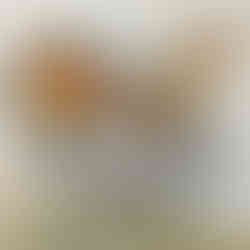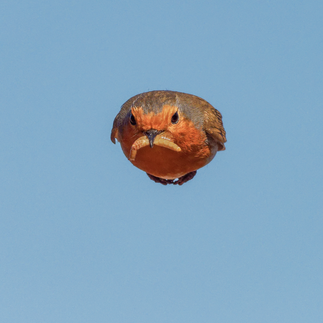The Robin - A Tale for Yuletide
- The Pondering of an Artist 💜

- Dec 7, 2022
- 4 min read
Updated: Jan 7, 2023

Robin Redbreast by William Allingham
"The fireside for the cricket,
The wheat stack for the mouse,
When trembling night-winds whistle
And moan all around the house;
The frosty ways like iron,
The branches plumed with snow,
Alas! In winter, dead and dark,
Where can poor Robin go?
Robin, Robin Redbreast,
O Robin dear!
And a crumb of bread for Robin,
His little heart to cheer."
December is the month that brings the first days of Winter, the final full moon on the 7th of December, called the Cold Moon, signifying the long, dark winter nights. Then we have Winter Solstice, known as Geola, by the Anglo Saxons, a turning point when the days, albeit very slowly, start to get lighter and longer, leading us to Yuletide. I can't wait to get the Christmas tree up and it seems to get earlier every year. By the 1st of December the tree is normally in place, bringing light and warmth into the house. Brightening up the dark afternoons and evenings with the gentle glow of twinkly festive lights. It's always exciting to receive the first Christmas cards through the letterbox and nearly always the robin is featured, perching on a gatepost, letterbox or tree branch with a snowy background.
Robin, Erithacus Rubecula, is the quintessential winter bird. I am among many gardeners who have discovered that robins are tame little birds. I see them every day and have a couple in the garden that often keep me company whilst I'm pottering. The lovely comforting song of the robin, often perching close by or hopping busily around the borders and veg beds. The unmistakable flash of orangey red on the chest. They are often rewarded with a handful of tasty mealworms. I am yet to have the pleasure of a robin eating from my hand, but I have heard of robins that do just that. Whilst out walking I often see one or two along the way, busy in the hedgerows or singing away from a branch or a garden wall. A beautiful, distinct melody, but singing in winter for both males and females is to defend their territory and food supply against incomers and I often hear them having a squabble on fine winter days. Another reason for the singing is that robins have been known to pair up in early December, though the traditional time is February.
The robin tends to be a big part of our festive traditions and artists love to paint these little garden visitors. I have painted several over the years, turning them into Christmas cards for friends and family. Robins on cards are believed to have first appeared around 1880.
The Robins strongest associations with Christmas can be traced back to long before the bird was named Britain's national bird in 1960 and again in 2015. In Victorian times, postal workers delivering Christmas cards were nicknamed Robins, as their red jackets resembled the robin's red breast.
According to legend the robin was present at Jesus' birth. The little robin hopped to close to the fire in the stable where Mary was giving birth and was scorched by the fire embers, gaining the red breast which was then passed on through the generations. The little robin dropped fresh dry sticks on to the dying fire and bellowed the embers with his wings, reigniting the fire and thus keeping the baby Jesus warm. Mary thanked and praised the robin for what he had done. Mary said tenderly to the little bird, "from now on let your red breast be a blessed reminder of your noble deed." Another legend suggests that the robin's redbreast is because of the association with Christ's death and crucifixion. Whilst Jesus was on the road to Calvary, it is said the robin plucked a thorn from Jesus' temple and a drop of Jesus' blood fell on the robin's chest, staining it red.
Along the way whilst pursuing my love for art and nature I have been fortunate enough to meet some very talented artists who have helped and encouraged me. I am grateful to have become acquainted with a photographer who has kindly given me access to some of his wonderful photographs. Martin Abbess photographs nature and sports using his Olympus and Canon cameras and an iPhone. He regularly posts his photographs on Instagram and you can find him @mart_the_gooner. It's really worth taking a look as Martin captures many birds, people and even the night sky whilst in motion. One lazy Sunday morning whilst slowly getting on with my chores I had the TV on in the background. Love your Weekend, hosted by Alan Titchmarsh on ITV, showed one of Martin's photographs. A robin in flight with a tasty meal worm in his beak, a truly spectacular photograph. This little robin then went on to feature in many daily tabloids, including The Times, The Sunday Times, The Telegraph, The Daily Mail and The Daily Star. A big thank you to Martin who has given me permission to share some of his robin photos with you.
Robins are a spiritual symbol and a visit from a robin is believed to signify the presence of a loved one who has passed, a sign that they are at peace. A messenger for the loved ones we have lost.
"When robins appear, loved ones are near."
Christmas is a time of celebration, gratitude, love and magic, but can also be a sad time, a lonely time. We remember friends and family that have passed, an emotional time of remembrance and nostalgia. The plucky little robins that visit my garden bring me cheer and comfort and I believe a message from loved ones that have already passed over. Robins can bring happiness, joy and luck. They symbolise strong marriages and the ending of an old phase, with the promise of something new, which leaves me to wish you all a happy and joyous Yuletide, Winter Solstice and Christmas and a bright, peaceful new year. A big thank you for taking the time to read my monthly blog posts. I hope you have enjoyed them. I will be back in January 2023 with more from 'The Pondering of an Artist' and of course you can find me on Instagram @purpleladybirdart. Keep shining your light this Christmas as it gives permission for others to do the same.
Sending you love & light,
Clare
Stay Naturally Curious...
Website Resources
www.birdspot.co.uk
www.rspb.org.uk
wwwbirdfact.com
Unsplash for beautiful source photographs
Youtube
Green Renaissance
Jonna Jinton - A lovely Vlog about life in Sweden
Books
The Robin: A Biography by Stephen Moss
A Treasury of British Folklore by Dee Dee Chainey
Winters in the World: A Journey through the Anglo-Saxon Year by Eleanor Parker






















Lovely post Clare and interesting to read some of the stories surrounding our treasured feathered friend. Nothing cheers me more than hearing a robin’s song on a crisp winter day. They are such feisty personalities and, like you, I see them often when gardening. Thanks for taking time to share all you do with us. Your art is beautiful (those holly leaves!) and I look forward to enjoying another year of blogposts. Wishing you a very merry festive season 🎄.